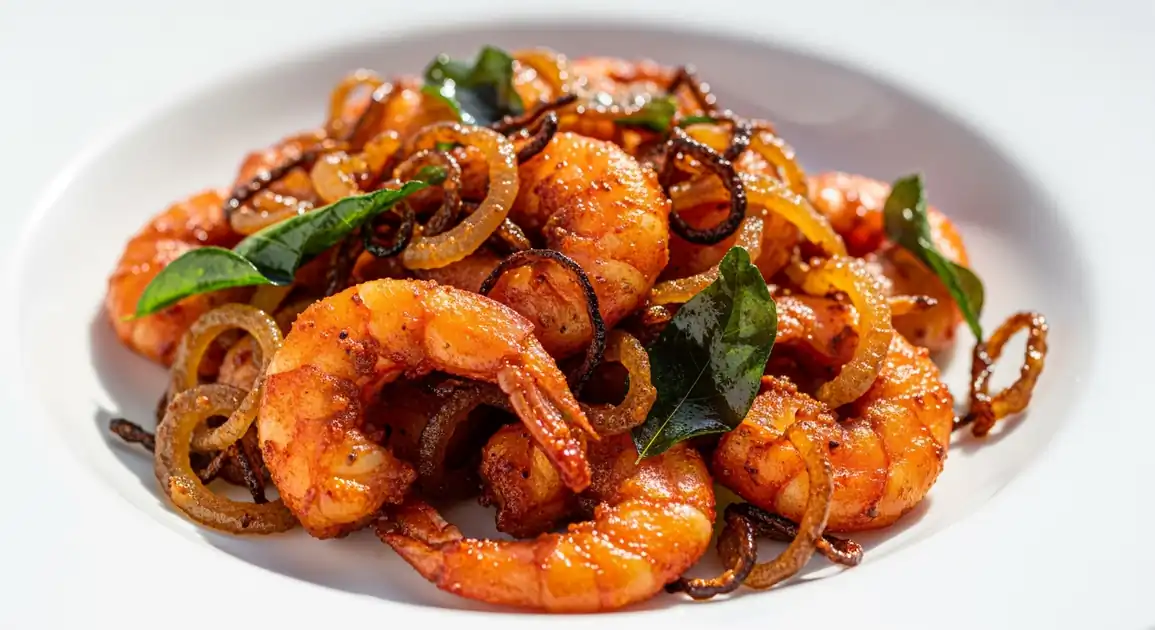Isso Baduma (Spicy Fried Shrimp)
ඉස්සෝ බැදුම

Description
Isso Baduma is a widely popular snack and side dish found throughout Sri Lanka, particularly beloved in coastal regions where fresh shrimp is readily available. It's a staple 'bite' in local bars and small eateries ('hotels').
Dietary Information
Serving information
Serving style
Served hot, often on a small plate, banana leaf square, or sometimes in a paper cone for takeaway. Eaten with fingers or a fork.
Quick facts
Roadside stalls: Often set up in the late afternoon and operate into the evening (e.g., 4 PM - 10 PM). Eateries/Bars: Available during their operating hours, especially evenings.
Safety Tips
What to Look For
-
Shrimp fried fresh to order ('aluthin badinna')
Ensures the dish is hot, crispy, and minimizes time for bacterial growth on the cooked seafood.
-
Hot, clean frying oil
Very hot oil ensures quick cooking and crispiness, reducing oil absorption. Relatively clean oil indicates better hygiene and taste.
-
Fresh appearance and smell of raw shrimp (if visible)
Raw shrimp should look translucent and plump, smelling fresh like the ocean. Avoid any dull, discolored, or foul-smelling shrimp.
-
High customer turnover
A busy stall usually means ingredients are replenished frequently and the food is freshly prepared.
-
Vendor uses clean utensils and serving paper/plates
Basic hygiene practices are essential to prevent cross-contamination.
What to avoid
-
Pre-fried Isso Baduma sitting in a large pile
Cooked shrimp left at ambient temperature, especially in heat, pose a significant food safety risk. They also lose their crispiness.
-
Oil that is very dark, dirty, or smells rancid
Old oil affects taste negatively and can contain harmful compounds. Dirty oil indicates poor hygiene.
-
Any 'off' smell (sour, ammoniated, overly fishy) from raw or cooked shrimp
This is a clear sign of spoilage. Do not consume.
-
Visible flies or pests around the food stall
Indicates unsanitary conditions and potential contamination.
-
Vendors handling money and food without washing hands or using gloves
Increases the risk of transferring bacteria to the food.
Price information
Price range
Budget tips
- Prices are generally lower at simple roadside stalls compared to restaurants or beach shacks catering to tourists.
- Portion sizes can vary; check the amount offered for the price.
- Often cheaper when ordered as part of a larger rice and curry meal.
Value indicators
- Generous portion of shrimp.
- Very crispy texture indicating fresh frying.
- Good balance of spice and flavor.
- Includes plenty of fried onions and curry leaves.
Where to Find This Dish
Coastal Towns
Abundant in beach towns along the south, west, and east coasts.
Beach roads, Near fishing harbors, Tourist areas
Afternoon, Evening
City Centers & Markets
Roadside stalls near bus stations, train stations, and busy market areas.
Central Bus Stand, Main Market, Pettah Market (Colombo)
Afternoon, Evening
Local Bars & 'Hotels'
Readily available in almost any establishment serving alcohol or local meals.
Neighborhood bars, Small eateries
Evening, Lunchtime
Vendor Tips
- Specify your preferred spice level ('sära aduwen' for less spicy, 'särata' for spicy).
- Observe if they are frying fresh batches regularly.
- Ask locals for recommendations for the best Isso Baduma spots.
How to Order
Regional Variations
-
Isso Kankun Baduma
(ඉස්සෝ කංකුං බැදුම)
Fried shrimp combined with stir-fried water spinach (kankun), onions, and spices. Less crispy than plain Isso Baduma.
-
Isso Thel Daala / Devilled Shrimp
(ඉස්සෝ තෙල් දාලා)
A 'devilled' version where fried shrimp are tossed in a spicy, tangy, slightly sweet sauce with onions, capsicums, and tomatoes. It's saucier and less purely crispy.
-
Variable Spice Levels
(සැර / මද සැර)
Vendors can often adjust the spiciness ('sära') based on request, from very spicy ('hondaytoma sära') to medium ('mada sära') or less spicy ('sära aduwen').
Cultural context
History
Rooted in Sri Lanka's rich coastal traditions and love for seafood, Isso Baduma evolved as a simple yet flavorful way to prepare abundant shrimp. Its popularity surged as a favored accompaniment ('bite') in bars and casual eateries ('hotels') across the island, becoming a staple finger food enjoyed by locals from all walks of life, particularly in seaside areas.
Local significance
Isso Baduma is a beloved part of Sri Lankan casual dining and social culture. It's a go-to 'bite' that embodies the island's love for spice and seafood.
Eating customs
- Typically eaten with fingers.
- The crispy shells of small shrimp are often eaten.
- Best enjoyed hot and fresh immediately after frying.